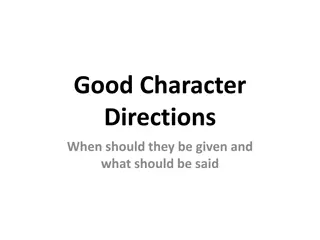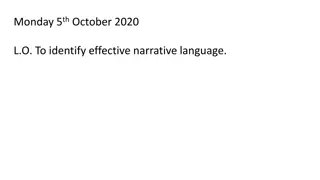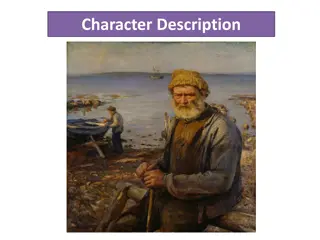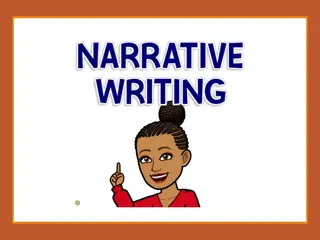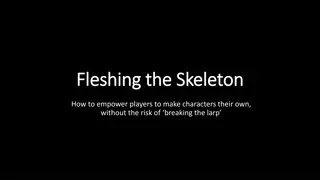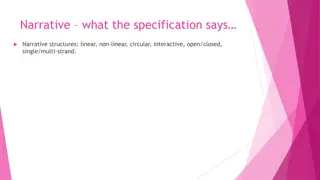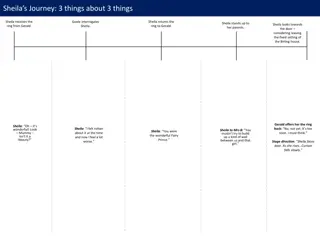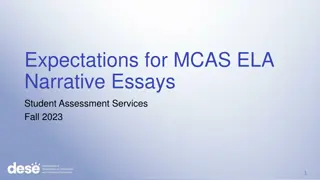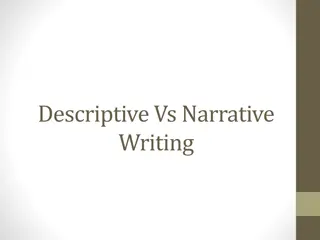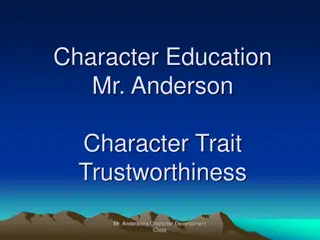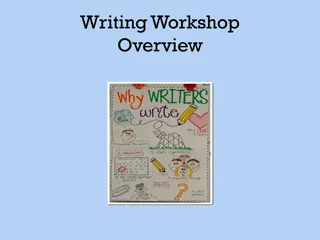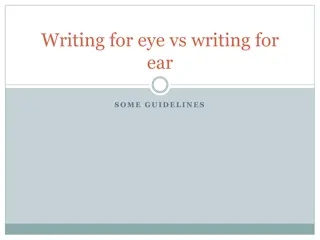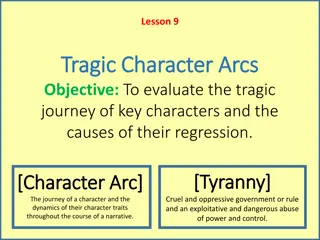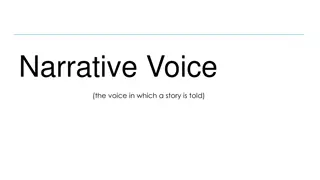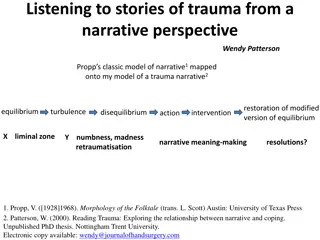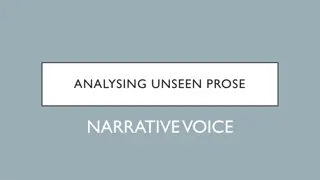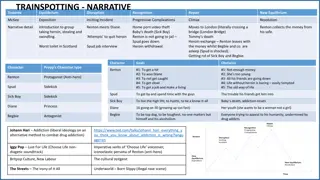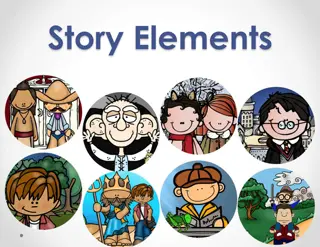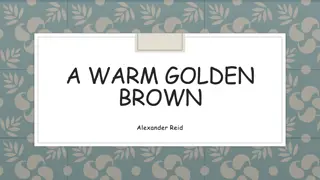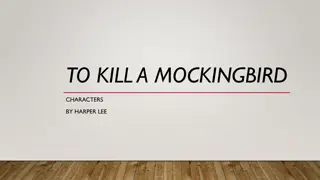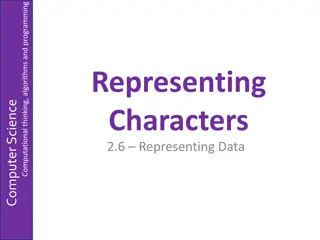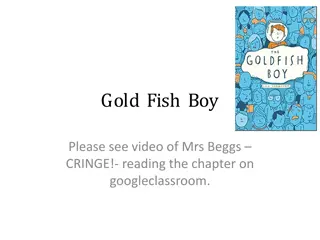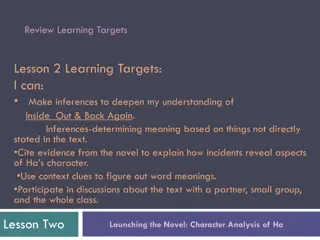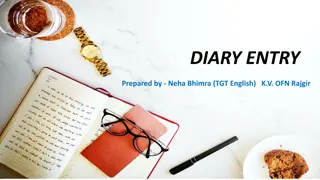Effective Character Development in Narrative Writing
Learn how to create compelling characters in narrative writing by showing, not telling. Discover the importance of using specific details, visual descriptions, character names, inner reflections, and dialogue to bring characters to life for readers. Examples from authentic texts illustrate the power of inference in character portrayal.
Download Presentation

Please find below an Image/Link to download the presentation.
The content on the website is provided AS IS for your information and personal use only. It may not be sold, licensed, or shared on other websites without obtaining consent from the author. Download presentation by click this link. If you encounter any issues during the download, it is possible that the publisher has removed the file from their server.
E N D
Presentation Transcript
Creating characters in narrative: Using verbs to show not tell
LEAD Principles PRINCIPLE LINKS EXPLANATION RATIONALE To establish a purposeful learning reason for addressing grammar, and connect grammar with meaning and rhetorical effect Make a link between the grammar being introduced and how it works in the writing being taught To avoid writing lessons becoming mini- grammar lessons, and to allow access to the structure even if the grammar concept is not fully understood To integrate reading and writing and show how real writers make language choices EXAMPLES Explain the grammar through examples, not lengthy explanations AUTHENTIC TEXTS Use authentic texts as models to link writers to the broader community of writers To promote deep metalinguistic learning about why a particular choice works, and to develop independence rather than compliance DISCUSSION Build in high-quality discussion about grammar and its effects
Creating Characters in Narrative Show not tell: reveal your character through showing what they are like, not just telling the reader; Use specific, concrete detail to describe characters to make your readers believe in them; Create strong visual descriptions which allow your reader to see the character in their own mind s eye; Think about how you name your characters; Reveal inner reflections so your readers know what your characters are thinking and feeling; Use dialogue to reveal your character.
Show, not Tell: make your reader infer Authentic text Mr Wormwood was a nasty little man. Mr Wormwood was a small ratty-looking man whose front teeth stuck out underneath a thin ratty moustache. Show not tell: Dahl doesn t tell us that Mr Wormwood is a nasty little man. He shows us he is a nasty little man through the detail that he looks like a rat. When we write, sometimes we do tell our readers about characters, but good writers also make the reader infer what the character is like. Links
Show, not Tell: make your reader infer Authentic text Miss Trunchbull, the Headmistress, was something else altogether. She was a gigantic holy terror, a fierce tyrannical monster who frightened the life out of the pupils and teachers alike. Here, Dahl tells us that Miss Trunchbull is a huge and terrifying figure. When we write, sometimes we do tell our readers about characters, but good writers also make the reader infer what the character is like. How could you show that Miss Trunchbull is terrifying by the way that she moves through the school? Links
Noticing Patterns in a Text Examples When she ...... Miss Trunchbull never walked, she always ....... like a Stormtrooper with long strides and arms aswinging when she.......... along a corridor you could actually hear her snorting as she went, and if a group of children happened to be in her path, she ploughed through them like a tank, bouncing off her to left and right. Matilda Roald Dahl Here, Dahl shows us how terrifying Miss Trunchbull is by the way that she moves through the school. What do you think is the missing verb? Discussion
Noticing Patterns in a Text Examples When she marched Miss Trunchbull never walked, she always marched like a Stormtrooper with long strides and arms aswinging when she marched along a corridor you could actually hear her snorting as she went, and if a group of children happened to be in her path, she ploughed through them like a tank, bouncing off her to left and right. Matilda Roald Dahl the fold What does the verb marched show us about Miss Trunchbull? Why do you think Dahl repeats the same verb? Discussion
Noticing Patterns in a Text Examples When she marched Miss Trunchbull never walked, she always marched like a Stormtrooper with long strides and arms aswinging when she marched along a corridor you could actually hear her snorting as she went, and if a group of children happened to be in her path, she ploughed through them like a tank, bouncing off her to left and right. Matilda Roald Dahl the fold What does the verb snorting make us infer about Miss Trunchbull? Discussion
Noticing Patterns in a Text Examples When she marched Miss Trunchbull never walked, she always marched like a Stormtrooper with long strides and arms aswinging when she marched along a corridor you could actually hear her snorting as she went, and if a group of children happened to be in her path, she ploughed through them like a tank, bouncing off her to left and right. Matilda Roald Dahl the fold What is the effect of choosing the verb happened to describe the children? Discussion
Creating Characters in Narrative Show not tell: reveal your character through showing what they are like, not just telling the reader; Use specific, concrete detail to describe characters to make your readers believe in them; Create strong visual descriptions which allow your reader to see the character in their own mind s eye; Think about how you name your characters; Reveal inner reflections so your readers know what your characters are thinking and feeling; Use dialogue to reveal your character.
Verbalising the Grammar-Writing Link A crucial element of the LEAD principles is helping writers to think explicitly (metalinguistically) about the choices they make. As a teacher, you need to support this by being crystal clear yourself about how you verbalise the link between a grammar choice and its effect in a particular text/context. Then express this in student-friendly language, as below. Verbalisation to share with students: When you are writing narrative, you can reveal your character by showing what they are like, not just telling the reader about them. You might choose verbs that show how your character moves and acts. Choose your verbs carefully!
Noticing Patterns in a Text At that moment, from outside in the courtyard, came the clatter of horses hooves on the cobbles. The doors of the hall flew open, and before I had time to call for them to be closed, a giant of a man rode in on a towering warhorse that pawed the ground, sides lathered up, tossing its fine head, snorting its fury. The man swept the hall with terrible eyes, wolfish eyes that froze the courage in a man s veins, eyes you could not hold with your own. But it was not the man s eyes that amazed us most, it was not his size either - and I tell you I d never in my life set eyes on a bigger man no. It was the colour of him. Green, the man was green from head to foot .He wore no armour but carried a green axe in one hand and in the other a branch he d ripped off some holly tree a sign of peace, but he didn t look very peaceful to me. Arthur, High King of Britain by Michael Morpurgo


